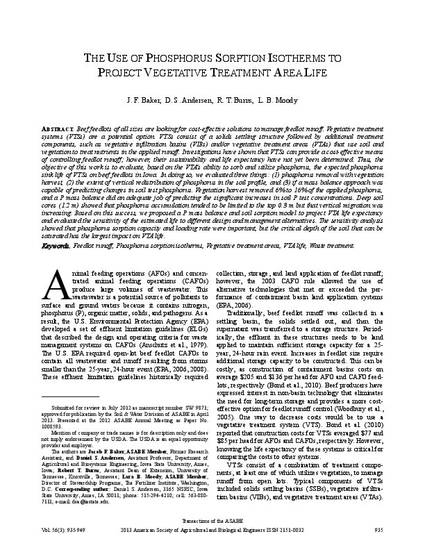
Beef feedlots of all sizes are looking for cost-effective solutions to manage feedlot runoff. Vegetative treatment systems (VTSs) are a potential option. VTSs consist of a solids settling structure followed by additional treatment components, such as vegetative infiltration basins (VIBs) and/or vegetative treatment areas (VTAs) that use soil and vegetation to treat nutrients in the applied runoff. Investigations have shown that VTSs can provide a cost-effective means of controlling feedlot runoff; however, their sustainability and life expectancy have not yet been determined. Thus, the objective of this work is to evaluate, based on the VTA’s ability to sorb and utilize phosphorus, the expected phosphorus sink life of VTSs on beef feedlots in Iowa. In doing so, we evaluated three things: (1) phosphorus removal with vegetation harvest, (2) the extent of vertical redistribution of phosphorus in the soil profile, and (3) if a mass balance approach was capable of predicting changes in soil test phosphorus. Vegetation harvest removed 6% to 16% of the applied phosphorus, and a P mass balance did an adequate job of predicting the significant increases in soil P test concentrations. Deep soil cores (1.2 m) showed that phosphorus accumulation tended to be limited to the top 0.3 m but that vertical migration was increasing. Based on this success, we proposed a P mass balance and soil sorption model to project VTA life expectancy and evaluated the sensitivity of the estimated life to different design and management alternatives. The sensitivity analysis showed that phosphorus sorption capacity and loading rate were important, but the critical depth of the soil that can be saturated has the largest impact on VTA life.
Available at: http://works.bepress.com/daniel_andersen/17/

This article is from Transactions of the ASABE 56, no. 3 (2013): 935–949, doi:10.13031/trans.56.9871.